Input interpretation

KOH potassium hydroxide ⟶ KOH potassium hydroxide
Balanced equation
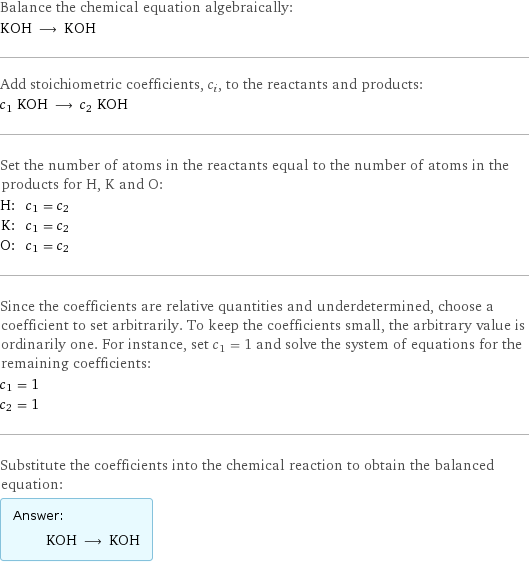
Balance the chemical equation algebraically: KOH ⟶ KOH Add stoichiometric coefficients, c_i, to the reactants and products: c_1 KOH ⟶ c_2 KOH Set the number of atoms in the reactants equal to the number of atoms in the products for H, K and O: H: | c_1 = c_2 K: | c_1 = c_2 O: | c_1 = c_2 Since the coefficients are relative quantities and underdetermined, choose a coefficient to set arbitrarily. To keep the coefficients small, the arbitrary value is ordinarily one. For instance, set c_1 = 1 and solve the system of equations for the remaining coefficients: c_1 = 1 c_2 = 1 Substitute the coefficients into the chemical reaction to obtain the balanced equation: Answer: | | KOH ⟶ KOH
Structures

⟶
Names

potassium hydroxide ⟶ potassium hydroxide
Reaction thermodynamics
Enthalpy
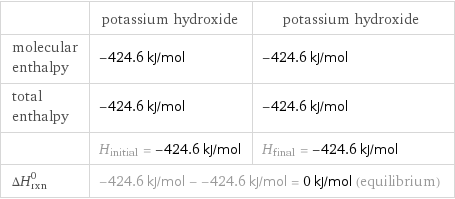
| potassium hydroxide | potassium hydroxide molecular enthalpy | -424.6 kJ/mol | -424.6 kJ/mol total enthalpy | -424.6 kJ/mol | -424.6 kJ/mol | H_initial = -424.6 kJ/mol | H_final = -424.6 kJ/mol ΔH_rxn^0 | -424.6 kJ/mol - -424.6 kJ/mol = 0 kJ/mol (equilibrium) |
Gibbs free energy
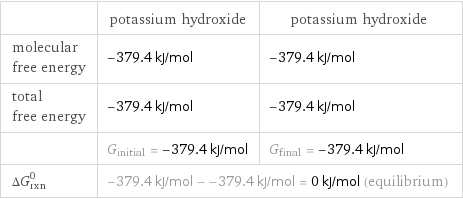
| potassium hydroxide | potassium hydroxide molecular free energy | -379.4 kJ/mol | -379.4 kJ/mol total free energy | -379.4 kJ/mol | -379.4 kJ/mol | G_initial = -379.4 kJ/mol | G_final = -379.4 kJ/mol ΔG_rxn^0 | -379.4 kJ/mol - -379.4 kJ/mol = 0 kJ/mol (equilibrium) |
Entropy
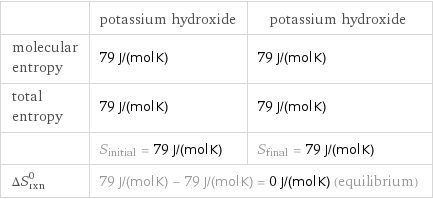
| potassium hydroxide | potassium hydroxide molecular entropy | 79 J/(mol K) | 79 J/(mol K) total entropy | 79 J/(mol K) | 79 J/(mol K) | S_initial = 79 J/(mol K) | S_final = 79 J/(mol K) ΔS_rxn^0 | 79 J/(mol K) - 79 J/(mol K) = 0 J/(mol K) (equilibrium) |
Equilibrium constant
![Construct the equilibrium constant, K, expression for: KOH ⟶ KOH Plan: • Balance the chemical equation. • Determine the stoichiometric numbers. • Assemble the activity expression for each chemical species. • Use the activity expressions to build the equilibrium constant expression. Write the balanced chemical equation: KOH ⟶ KOH Assign stoichiometric numbers, ν_i, using the stoichiometric coefficients, c_i, from the balanced chemical equation in the following manner: ν_i = -c_i for reactants and ν_i = c_i for products: chemical species | c_i | ν_i KOH | 1 | -1 KOH | 1 | 1 Assemble the activity expressions accounting for the state of matter and ν_i: chemical species | c_i | ν_i | activity expression KOH | 1 | -1 | ([KOH])^(-1) KOH | 1 | 1 | [KOH] The equilibrium constant symbol in the concentration basis is: K_c Mulitply the activity expressions to arrive at the K_c expression: Answer: | | K_c = ([KOH])^(-1) [KOH] = ([KOH])/([KOH])](../image_source/bb5fdd883b9696631bc596f15c8a1b6f.png)
Construct the equilibrium constant, K, expression for: KOH ⟶ KOH Plan: • Balance the chemical equation. • Determine the stoichiometric numbers. • Assemble the activity expression for each chemical species. • Use the activity expressions to build the equilibrium constant expression. Write the balanced chemical equation: KOH ⟶ KOH Assign stoichiometric numbers, ν_i, using the stoichiometric coefficients, c_i, from the balanced chemical equation in the following manner: ν_i = -c_i for reactants and ν_i = c_i for products: chemical species | c_i | ν_i KOH | 1 | -1 KOH | 1 | 1 Assemble the activity expressions accounting for the state of matter and ν_i: chemical species | c_i | ν_i | activity expression KOH | 1 | -1 | ([KOH])^(-1) KOH | 1 | 1 | [KOH] The equilibrium constant symbol in the concentration basis is: K_c Mulitply the activity expressions to arrive at the K_c expression: Answer: | | K_c = ([KOH])^(-1) [KOH] = ([KOH])/([KOH])
Rate of reaction
![Construct the rate of reaction expression for: KOH ⟶ KOH Plan: • Balance the chemical equation. • Determine the stoichiometric numbers. • Assemble the rate term for each chemical species. • Write the rate of reaction expression. Write the balanced chemical equation: KOH ⟶ KOH Assign stoichiometric numbers, ν_i, using the stoichiometric coefficients, c_i, from the balanced chemical equation in the following manner: ν_i = -c_i for reactants and ν_i = c_i for products: chemical species | c_i | ν_i KOH | 1 | -1 KOH | 1 | 1 The rate term for each chemical species, B_i, is 1/ν_i(Δ[B_i])/(Δt) where [B_i] is the amount concentration and t is time: chemical species | c_i | ν_i | rate term KOH | 1 | -1 | -(Δ[KOH])/(Δt) KOH | 1 | 1 | (Δ[KOH])/(Δt) (for infinitesimal rate of change, replace Δ with d) Set the rate terms equal to each other to arrive at the rate expression: Answer: | | rate = -(Δ[KOH])/(Δt) = (Δ[KOH])/(Δt) (assuming constant volume and no accumulation of intermediates or side products)](../image_source/db58f73d6cc6f094642ab27bf9a27dee.png)
Construct the rate of reaction expression for: KOH ⟶ KOH Plan: • Balance the chemical equation. • Determine the stoichiometric numbers. • Assemble the rate term for each chemical species. • Write the rate of reaction expression. Write the balanced chemical equation: KOH ⟶ KOH Assign stoichiometric numbers, ν_i, using the stoichiometric coefficients, c_i, from the balanced chemical equation in the following manner: ν_i = -c_i for reactants and ν_i = c_i for products: chemical species | c_i | ν_i KOH | 1 | -1 KOH | 1 | 1 The rate term for each chemical species, B_i, is 1/ν_i(Δ[B_i])/(Δt) where [B_i] is the amount concentration and t is time: chemical species | c_i | ν_i | rate term KOH | 1 | -1 | -(Δ[KOH])/(Δt) KOH | 1 | 1 | (Δ[KOH])/(Δt) (for infinitesimal rate of change, replace Δ with d) Set the rate terms equal to each other to arrive at the rate expression: Answer: | | rate = -(Δ[KOH])/(Δt) = (Δ[KOH])/(Δt) (assuming constant volume and no accumulation of intermediates or side products)
Chemical names and formulas

| potassium hydroxide | potassium hydroxide formula | KOH | KOH Hill formula | HKO | HKO name | potassium hydroxide | potassium hydroxide
Substance properties
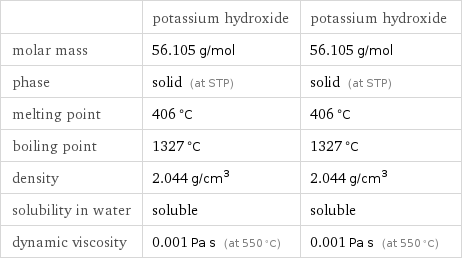
| potassium hydroxide | potassium hydroxide molar mass | 56.105 g/mol | 56.105 g/mol phase | solid (at STP) | solid (at STP) melting point | 406 °C | 406 °C boiling point | 1327 °C | 1327 °C density | 2.044 g/cm^3 | 2.044 g/cm^3 solubility in water | soluble | soluble dynamic viscosity | 0.001 Pa s (at 550 °C) | 0.001 Pa s (at 550 °C)
Units
